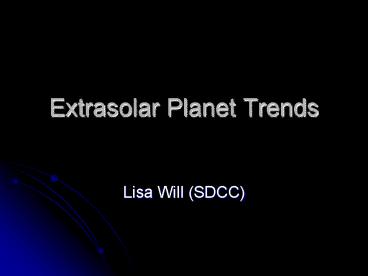Extrasolar Planet Trends - PowerPoint PPT Presentation
Title:
Extrasolar Planet Trends
Description:
Extrasolar planets are recent discoveries. Conclusion ... Are these discoveries a function of technology? Educator Implications ... – PowerPoint PPT presentation
Number of Views:43
Avg rating:3.0/5.0
Title: Extrasolar Planet Trends
1
Extrasolar Planet Trends
- Lisa Will (SDCC)
2
Research Focus
- Do extrasolar planets follow similar trends to
planets in our solar system? - This project can be completed with the
Interactive Extrasolar Planets Catalog available
at http//exoplanet.eu - Based on previous observations of our solar
system, we would expect planets of varying sizes
and distances from the parent star.
3
Context
- This experiment builds on the knowledge of the
solar system developed in previous exercises. - The experiment would be a part of the discussion
of how solar systems form - Do other solar systems exist?
- Is our solar system a model for others?
4
Method
- Interactive Extrasolar Planet Catalog
- Histograms
- Correlation diagrams
- gt Play with these functions!
- Many combinations of variables (number of
planets, discovery date, radius, semi-major axis,
mass, etc) are investigated to look for trends
5
Assessment
- Students would be assessed on correctly
interpreting the data. - Students would be expected to obtain enough data
to perceive trends.
6
Data Summary
7
Data Summary
8
Data Summary
9
Data Summary
10
Data Summary
11
Data Summary
- Extrasolar planets orbit close to their parent
stars (similar to our Terrestrials). - Extrasolar planets are massive (similar to our
Jovians). - Extrasolar planets are recent discoveries.
12
Conclusion
- Extrasolar planets do not resemble the variety of
planets in our solar system. - Extrasolar planets can be more massive than
Jupiter. - Extrasolar planets can orbit extremely close to
the parent star. - No terrestrial planets exist in these systems.
13
Implications
- We may not be seeing all of the planets in these
systems. - The discovery dates point to recent discoveries
- Are these planets newly born?
- Are these discoveries a function of technology?
14
Educator Implications
- This type of experiment has a few problems
- Experiment can be done mindlessly
- Students can leave without understanding why we
see so many large planets/close to parent stars.
- Great potential for future discussion
- Modeling planetary formation just on our solar
system does not give us all the answers! - Understanding limitations of methodology!































